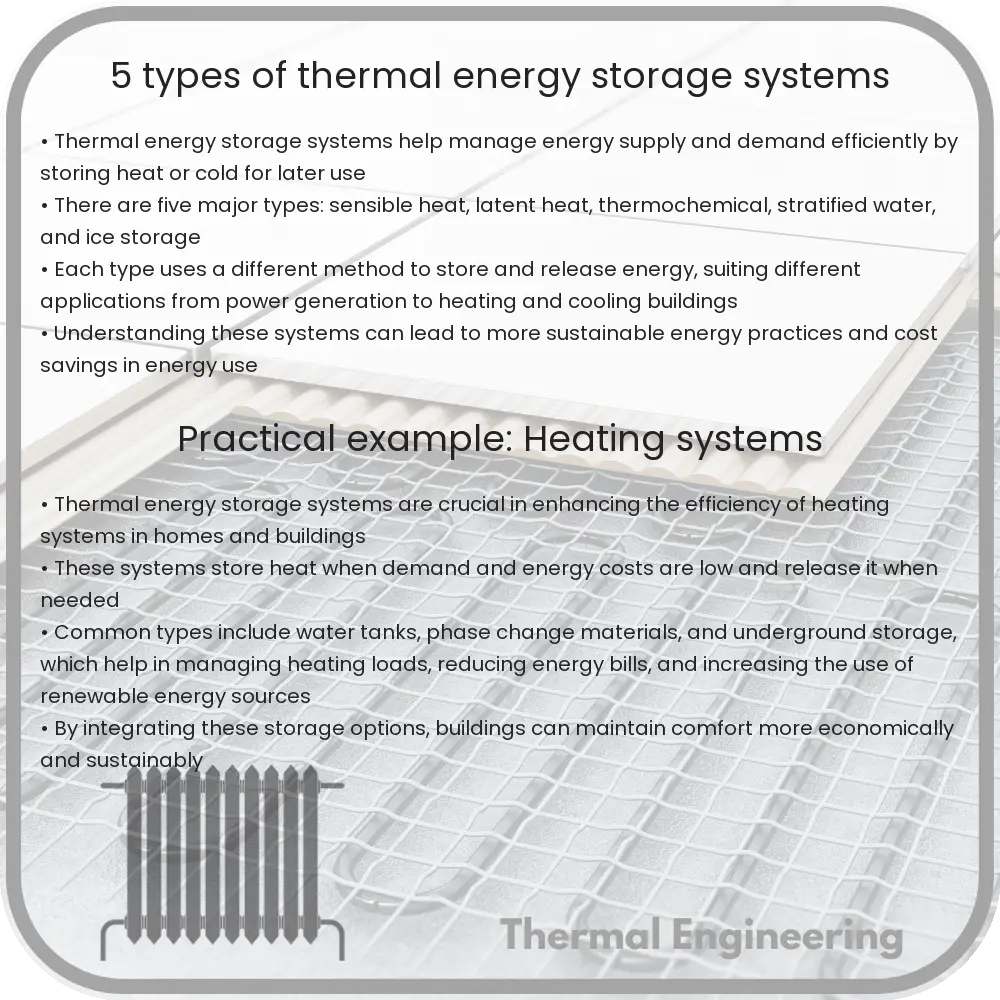Learn about thermal energy storage systems, their types, materials used, and their applications in improving energy efficiency.

Introduction to Thermal Energy Storage Systems
Thermal energy storage (TES) systems are crucial in the field of energy management, providing the ability to store thermal energy for later use. This can enhance energy savings, improve grid stability, and reduce the carbon footprint associated with heating and cooling in residential, industrial, and commercial sectors. There are several types of TES systems that vary based on the storage medium and technology used.
1. Sensible Heat Storage
Sensible heat storage systems operate by absorbing and releasing heat through changes in temperature of a storage medium. Common materials used include water, sand, and molten salts. These are popular due to their simplicity, cost-effectiveness, and the ability to work within a wide range of temperatures.
- Water: Most commonly used due to its high heat capacity and availability. Ideal for domestic hot water storage.
- Molten Salts: Typically used in solar power plants, where they store heat collected during the day to generate electricity at night.
- Rock and Sand: Cheaper materials that can store heat at higher temperatures, useful in industrial applications.
2. Latent Heat Storage
Latent heat storage utilizes phase change materials (PCMs) to store and release heat energy during the transition between phases, such as solid to liquid or liquid to gas. PCM can store more heat per unit volume than sensible heat storage materials, making them highly efficient for space-saving settings.
- Paraffin Waxes: Common in residential and commercial heating and cooling applications due to their moderate temperature range and high latent heat capacity.
- Salt Hydrates: Effective for higher temperature storage, used in industrial processes.
3. Thermochemical Storage
Thermochemical storage systems involve chemical reactions that absorb or release heat. This type of storage can achieve higher energy storage densities and is not dependent on the external environment, providing very stable long-term storage.
- The reactions are often reversible, allowing them to be charged and discharged repeatedly.
- Common materials include metal hydrides and zeolites.
4. Ice Storage
Ice storage technology is a practical application of the latent heat principle specifically for air conditioning systems. By freezing water at night (when the demand for electricity is lower) and melting it during the day, the system can significantly reduce the cost and energy required for cooling during peak hours.
- It helps in shifting energy use from peak to off-peak hours.
- Can be integrated with standard HVAC systems in commercial buildings.
5. Eutectic Systems
Eutectic systems are another type of phase change system, but they use solutions that solidify at a constant temperature. These systems are often used for temperature-controlled transport and solar air conditioning systems. The eutectic salts have fixed points of solidification, making them ideal for maintaining precise temperature conditions.
- Eutectic salts: Used in applications demanding constant temperature regulation.
- Can be engineered to melt or freeze at different temperatures suitable for specific requirements.
Conclusion
Thermal energy storage systems play an essential role in enhancing energy efficiency and helping to balance supply and demand in various engineering applications. Each type of TES system provides unique benefits and is chosen based on specific needs related to temperature range, storage capacity, and cost-effectiveness. As technology progresses, the use of these systems is expected to increase, driving further innovations in this field.